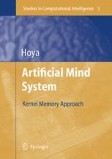Search
Search Results
-
The Kernel Memory Concept – A Paradigm Shift from Conventional Connectionism
In this chapter, the general concept of kernel memory (KM) is described, which is given as the basis for not only representing the general notion of...
-
Modelling Abstract Notions Relevant to the Mind and the Associated Modules
This chapter is devoted to the remaining four modules within the AMS, i.e. 1) attention, 2) emotion, 3) intention, and 4) intuition module, and their...
-
Bioinformatics with Evolutionary Computation
This chapter makes the presumption that it is more important to understand the domain of the problem of interest and to pursue the best achievable...
-
Virtual Reality in Healthcare
In our modern 21st century, daily life would be unthinkable without computers. Multimedia and virtual reality are useful for people with special...
-
Access to Information on Demand by the aid of Digital Talking Books
This chapter addresses the concept and the fundamental ideas of the digital talking book (DTB), with a particular focus on DTBs in the DAISY format....
-
Introduction
Genetic algorithms (GAs) are powerful search techniques based on principles of evolution. They are now widely applied to solve problems in many...
-
Linkage Learning Genetic Algorithm
In order to handle linkage evolution and to tackle the ordering problem, Harik [47] took Holland’s call [53] for the evolution of tight linkage quite...
-
Preliminaries: Assumptions and the Test Problem
After introducing the background and motivation of the linkage learning genetic algorithm, we will start to improve and understand the linkage...
-
Rough Set Theory with Applications to Data Mining
This paper is an introduction to rough set theory with an emphasis on applications to data mining. First, consistent data are discussed, including...
-
From Classical Connectionist Models to Probabilistic/Generalised Regression Neural Networks (PNNs/GRNNs)
This chapter begins by briefly summarising some of the well-known classical connectionist/artificial neural network models such as multi-layered...
-
Language and Thinking Modules
In this chapter, we focus upon the two modules which are closely tied to the concept of “action planning”, i.e. the 1) language and 2) thinking...
-
Sensation and Perception Modules
In any kind of creature, both the mechanisms of sensation and perception are indispensable for continuous living, e.g. to find edible plants/fruits...
-
Reinforcement Learning: A Brief Overview
Learning techniques can be usefully grouped by the type of feedback that is available to the learner. A commonly drawn distinction is that between...
-
An Analysis of Continuous-Valued Representations for Learning Classifier Systems
Learning Classifier Systems [11] typically use a ternary representation to encode the environmental condition that a classifier matches. However,...
-
Data Driven Fuzzy Modelling with Neural Networks
Extraction of models for complex systems from numerical data of behavior is studied. In particular, systems representable as sets of fuzzy if-then...
-
13 Usability of an Assistive Robot Manipulator: Toward a Quantitative User Evaluation
This chapter describes our research activity on the integration of a robotic arm in the environment of persons with disabilities. People who have...
-
2 Rehabilitation Robotics from Past to Present – A Historical Perspective
Popular culture presents the image of a robot as a mechanical, humanoid device, often evil in intent. Those with a slightly more informed technical...
-
12 Risk Reduction Mechanisms for Safe Rehabilitation Robots
Safety is one of the most important features of rehabilitation robots. However, strategies for safe rehabilitation robots are not yet clarified. A...
-
4 Welfare-Oriented Service Robotic Systems: Intelligent Sweet Home & KARES II
Utopia – it would be a society where the welfare of the people is properly guaranteed. In the society, each constituent would live his/her life with...
-
5 “FRIEND” – An Intelligent Assistant in Daily Life
The research and development in the field of rehabilitation robots produced a multiplicity of rehabilitation robots available as off-the- shelf...
